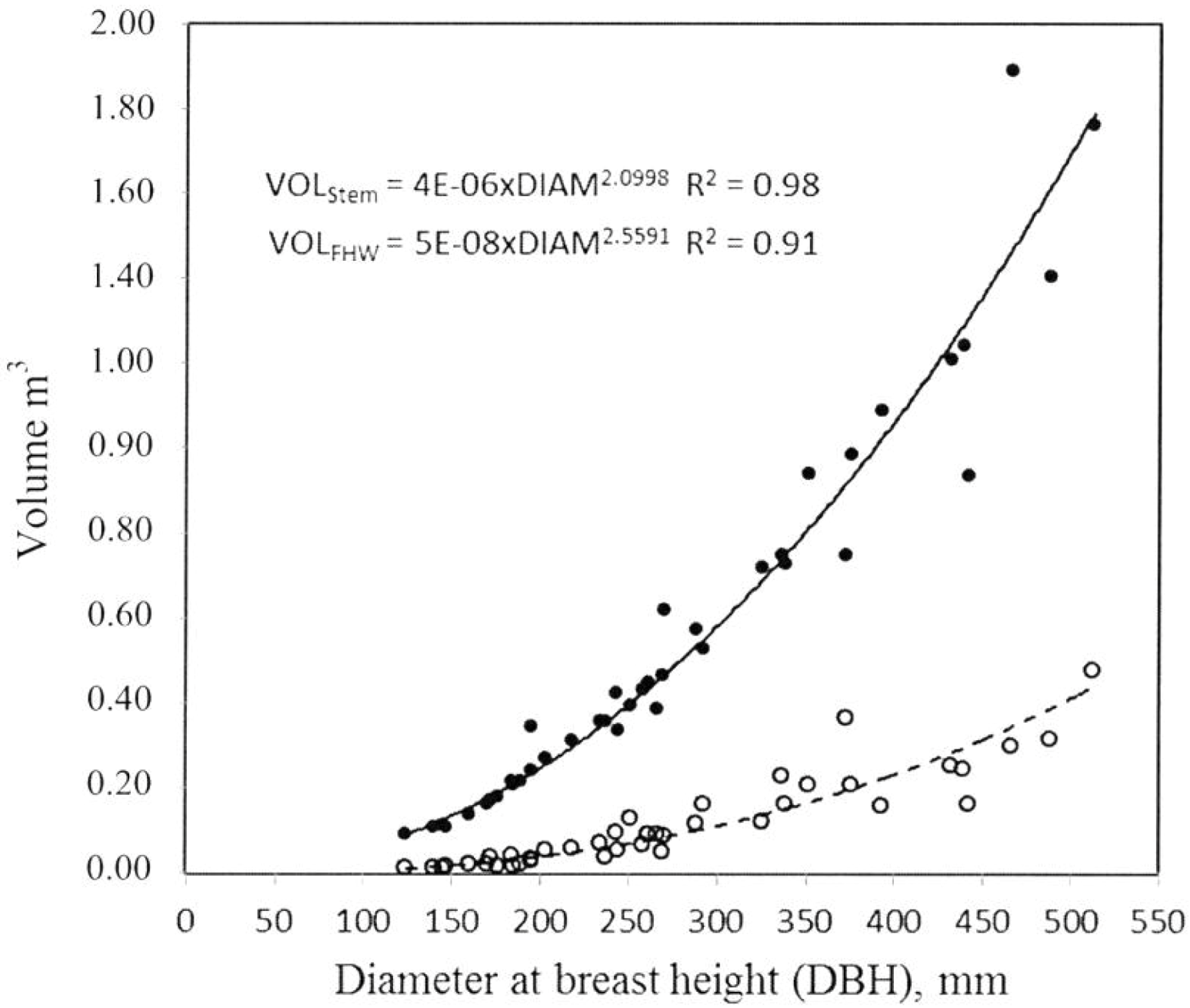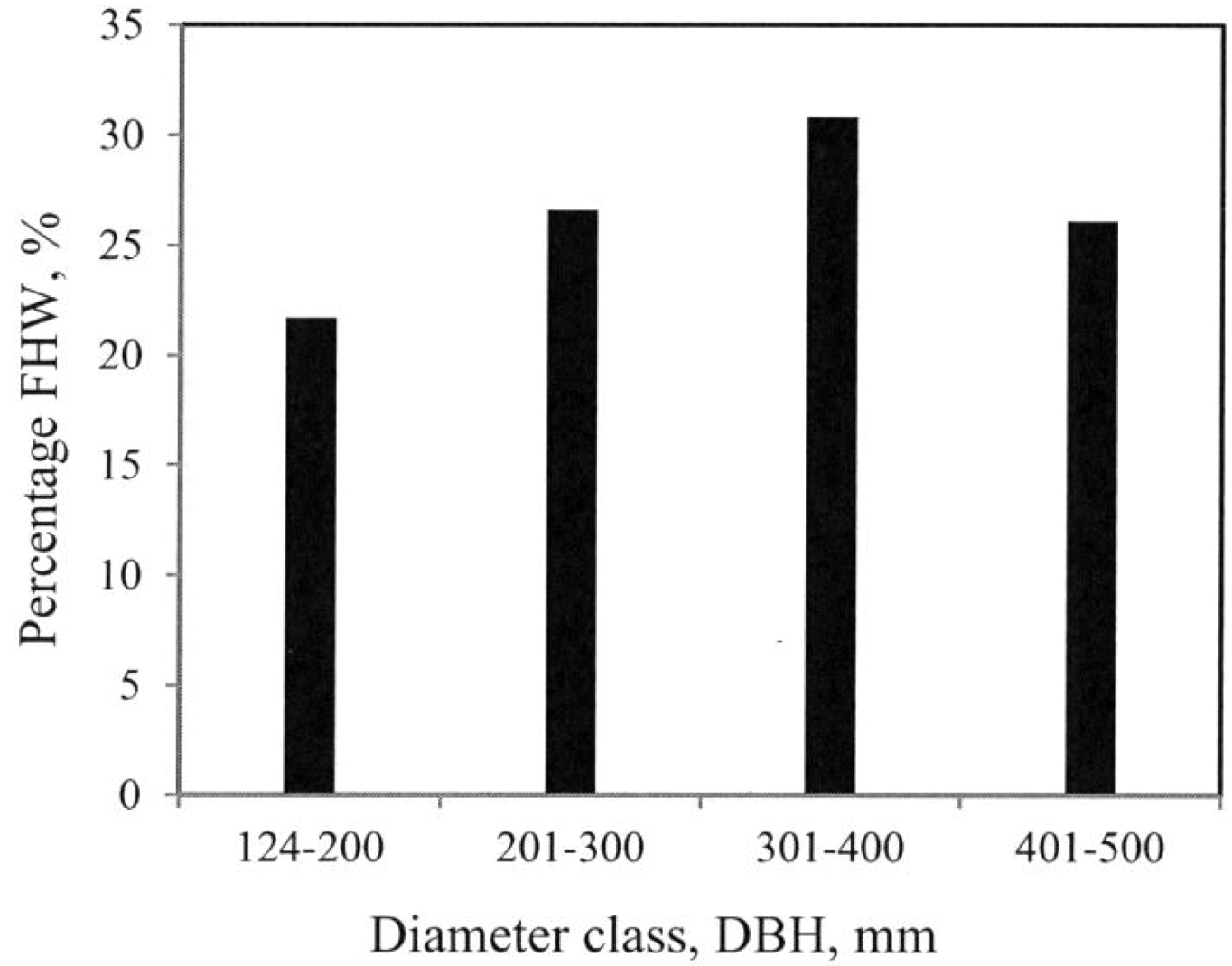1. Introduction
There has been a general increase in interest in the management of fast-growing broadleaved trees in the Nordic countries (and elsewhere). The earliest trials with poplars in Sweden started with plant material originating from Oregon and Washington, with the aim of breeding material for the Swedish Match Company [
1]. Poplar plantations in Sweden are now about 20 years old and their owners have to harvest the stands. In the future short rotation is a promising supply of poplar biomass in Sweden [
2]. In Yugoslavia, research on eastern cottonwood (
Populus deltoides Bartr.) has shown there is a high production of biomass over a short rotation (2–12 years) [
3].
However, forest owners and farmers are also interested in managing poplar for pulpwood and, in some cases, timber, despite the lack of suitable climate-adapted clones and uncertainties regarding appropriate management, pest control, economic factors and markets. Poplar stems cut in thinnings have contained discolored wood and the owners are concerned about quality and how frequently this discolored wood occurs.
The wood quality of different broadleaf species is defined according to their “natural” properties including the color of the wood. Mostly, the wood color is uniform from the pith to the cambium. However, for individuals, parts of the wood extending from the pith can be dark (red, brown, grey or black). Darkly colored wood is normal in some species [e.g., elm (
Ulmus sp.); oak (
Quercus sp.); sweet chestnut (
Castania sativa L.); black walnut (
Juglans regia L.)] and not classified as false heartwood. Wood discoloration has been reported for some broadleaved species: poplars [
4], beech, (
Fagus sylvatica L.) [
5], wild cherry (
Prunus avium L.) [
6], paper birch (
Betula papyrifera Marsh.) [
7], silver birch (
Betula pendula Roth) [
8] and ash (
Fraxinus excelsior L.) [
9].
When describing discoloration found in broadleaf species, there are different names for the phenomenon: affected wood, discolored wood, stained wood, wetwood, wounded wood, black heart, red heart, black heartwood, false heartwood, pathological heartwood, red heartwood
etc. [
10,
11,
12,
13,
14,
15,
16,
17]. There is no common name that has been officially accepted in the terminology. Here we use false heartwood (FHW) throughout the paper but, where quoted, we use the name as written in the referenced report.
Information about different types of discoloration and species is presented among others by Hörnfeldt
et al. [
18] who wrote an overview of FHW in beech, birch and ash. Kerr [
17] reviewed the occurrence of black heart in ash in relation to management and the influence on timber price and Ward and Pong [
19] reported on the available information about wetwood in trees.
Wetwood is a type of false heartwood and appears in aspen and poplar but also in willow (
Salix sp.) and fir (
Abies sp.) [
20]. What follows below is an overview about FHW or wetwood in poplar stems. True heartwood in aspen and poplar stems, if it exits, is difficult to distinguish in stems without discolored wood. Therefore, false heartwood in poplars is easy to observe. There are no published reports or first-hand experience of the importance and extent of false heartwood in poplar in Sweden. Below follows an overview of the main factors and experiences of this discolored wood, based on international scientific reports and knowledge.
Wetwood is a type of heartwood that has high water content [
19]. In a study of balsam poplar (
Populus basamifera L.) the moisture contents in sapwood was 122 (77–187)% and in wetwood 150 (100–216)% of oven dry weight [
21]. In the study pH in wetwood was slightly basic and in sapwood slightly acidity. A similar result was reported in a study of black poplar (
Poplulus nigra L.) [
22]. The odor of fresh wetwood indicates anaerobic bacteria activity [
19]. According to Wallin [
20] bacteria was more frequent in wetwood (92.5% of total isolation) of balsam poplar than in sapwood (54.4%). Poplars with wetwood contain large and diverse populations of bacteria [
23]. In a review of discoloration in the wood of living and cut tree species, Bauch [
24] concluded that discoloration including wetwood is caused by physiological processes (environmentally initiated), biochemical and chemical reactions.
Studies of the presence of FHW in poplar stems have been reported from different countries. Wang
et al. [
25] reported a distribution of wet wood in all stems of
P × xiaohei Hwang and Liang in stands growing in northern China. The heartwood area increased with decreasing stem number per hectare. In a study of 17 Fremont cottonwood (
Populus fremontii S. Watson) plantations in Arizona, all stands had wetwood symptoms [
4]. The percentage stems with wetwood in a stand varied depending on diameter. In the lowest diameter class (diameter at breast height (DBH) 1–32 cm), the percentage ranged from 14% to 80%. On the contrary, the frequency was correlated with stand density where dense stands (1–3 m) had the highest percentage.
According to the presented overview of the literature, discoloration of the wood of broadleaf species is common. From a practical point of view, there are different opinions about the quality of discolored wood in stems. Hiratsuka and Loman [
26] concluded, in a review of decay of aspen and balsam poplar in Alberta, that plywood production demands decay-free, high quality logs for veneer. Discolored wood reduces the veneer quality. To reduce the higher moisture content in poplar veneer logs to 5%, it requires 15% more time to dry than spruce. Sachs
et al. [
27] reported that wetwood took two to six times longer to dry than sapwood in order to reach a level of 6%–8% moisture. A similar conclusion about the need for a longer drying period is reported by Boone [
28]. Ward and Pong [
19] concluded in their overview that wetwood is a cause of losses of wood for the industry. The wood must be dried for 50% longer than fresh wood. Dried board made of wetwood could crack more and develop other quality defects. Control of moisture content in veneer from poplars with wetwood is a technical problem that causes disruption in the processing of veneer. There were no differences in basic density between sapwood and wetwood in balsam poplar [
21,
29]. However, Ward and Pong [
19] reported lower basic density in wetwood than in sapwood. They also reported that boards with wetwood might lower the strength properties.
In Sweden, there is great interest in the management of fast-growing broadleaved species. The demand for information about the wood quality of poplar has increased, as some of the oldest poplar plantations (20–25 years old) are now ready to be harvested. An important factor is false heartwood in poplar stems, which has been observed in thinnings after harvest. The owners want to know about the frequency of FHW in a stand, the formation in the stem, clone dependence, site relationships and influence on wood quality amongst other factors. The pulp industry has asked whether poplar wood is acceptable as pulp wood. As most of the poplar stems have discolored wood, the pulp industry may have objections about the quality and not buy the product. However, a mixture of pulp woods containing poplar with wetwood and sapwood has been shown to produce an acceptable quality of the pulp and paper when processed by pulp mills [
25]. Poplar is also an interesting source of material for the pulp industry in former Yugoslavia [
3].
The objectives of this paper are to present the available information about FHW in broadleaved species as a base for understanding the presence of heartwood in poplar stems. We present results from a study of FHW in living poplar stems growing on former farmland in Sweden.
5. Conclusions
This study has focused on the frequency of false heartwood in poplar stems. No studies on this phenomenon for poplars growing in Sweden have been described before.
There was FHW in all studied poplars. Only a few stems per stand could be felled and examined. In all studied stems, FHW was found in stem from sections at 1%, 10% and 30% of stem height.
As the variability of FHW dimensions is high the constructed function expressing the diameter of FHW for different stem heights, %, at different DBH is only a tool indicating the amount of FHW at different stem diameters. In a table the percentage FHW volume by total volume in the first 50% of stem height indicates an increasing FHW volume by increasing DBH.
Up to 50% of the radius at 30% of stem height was sapwood without FHW and might be used for veneer production. According to reports in the literature review poplar stems with FHW might be used as pulp wood. There are some doubts about the quality of poplar boards with wetwood. No reports have, to our knowledge been presented about disadvantages when using the stems with FHW as raw material for bioenergy.
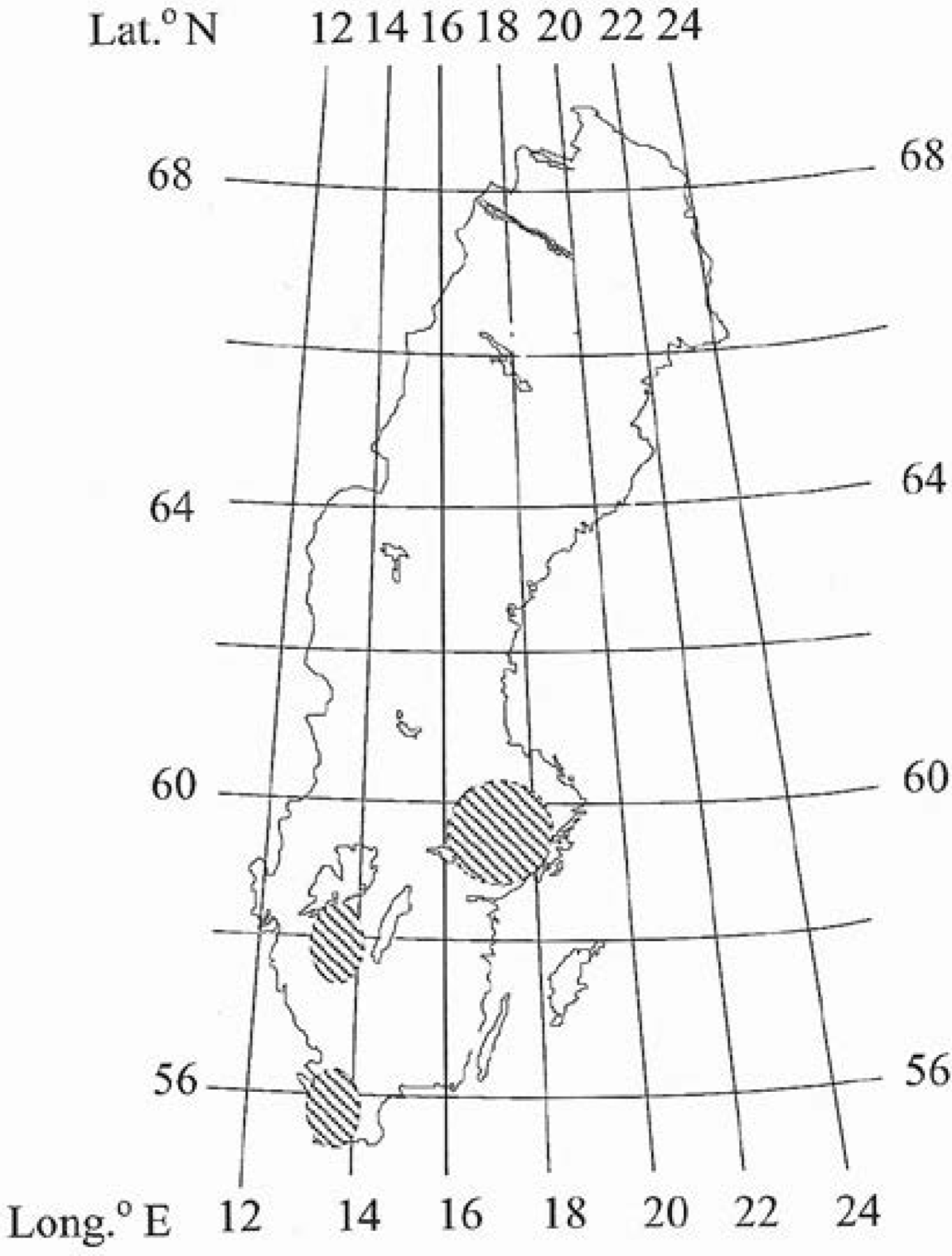
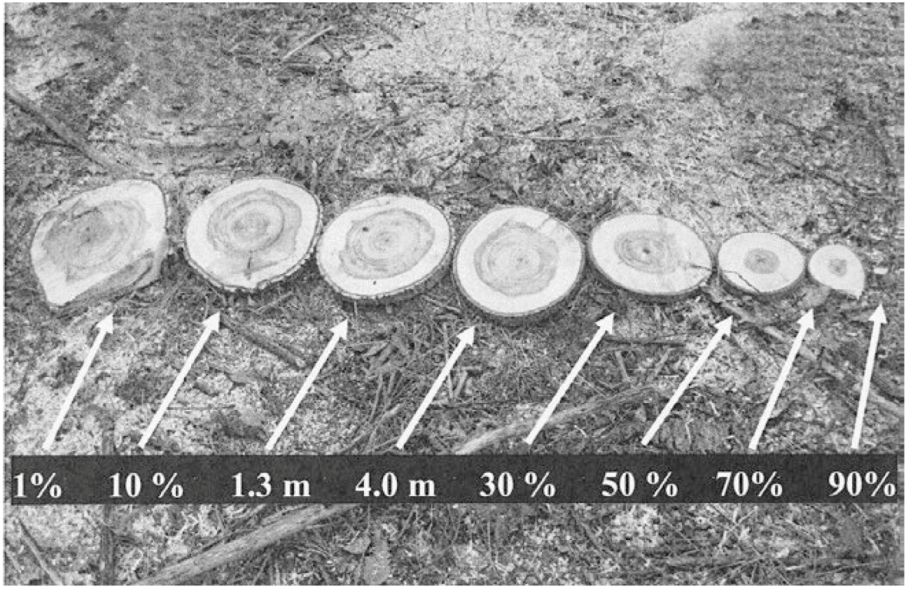



 and
and  are the observed, mean and predicted weights (w).
are the observed, mean and predicted weights (w).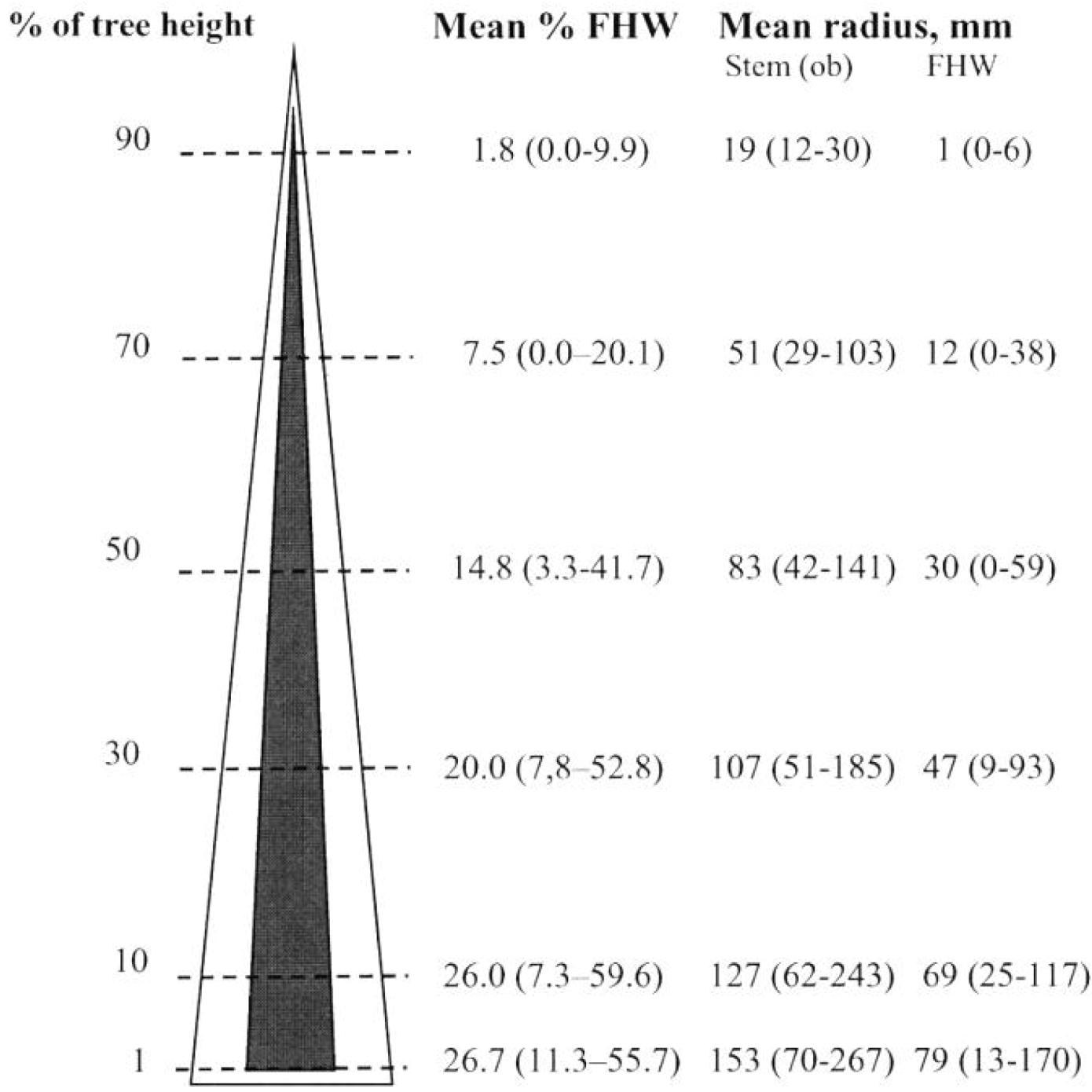
 ), 10% (
), 10% (  ), 30% (
), 30% (  ), 50% (
), 50% (  ), 70% (
), 70% (  ) and 90% (
) and 90% (  ) of tree height for poplar.
) of tree height for poplar.
 ), 10% (
), 10% (  ), 30% (
), 30% (  ), 50% (
), 50% (  ), 70% (
), 70% (  ) and 90% (
) and 90% (  ) of tree height for poplar.
) of tree height for poplar.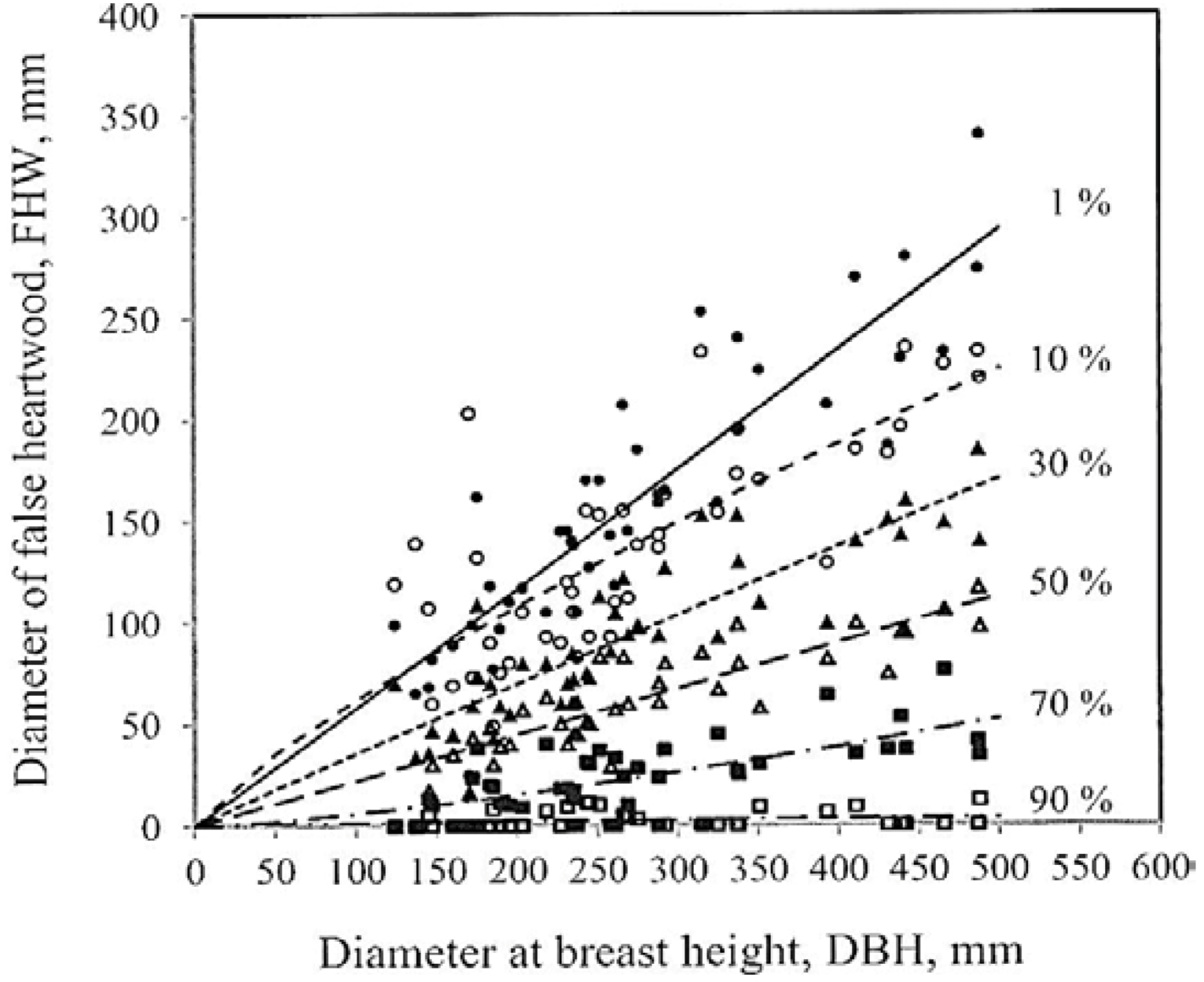
 ) and volume of FHW (
) and volume of FHW (  ), m3, in the first 50% of stem height for poplar.
), m3, in the first 50% of stem height for poplar. 